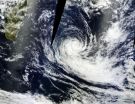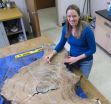(Press-News.org) CAMBRIDGE, Mass-- The heroes and villains in animated films tend to be on opposite ends of the moral spectrum. But they're often similar in their hair, which is usually extremely rigid or — if it moves at all — is straight and swings to and fro. It's rare to see an animated character with bouncy, curly hair, since computer animators don't have a simple mathematical means for describing it.
However, change may be coming soon to a theater near you: In a paper appearing in the Feb. 13 issue of Physical Review Letters, researchers at MIT and the Université Pierre et Marie Curie in Paris provide the first detailed model for the 3-D shape of a strand of curly hair.
This work could have applications in the computer animation film industry, but it also could be used by engineers to predict the curve that long steel pipes, tubing, and cable develop after being coiled around a spool for transport. In the field, these materials often act like a stubborn garden hose whose intrinsic curves make it behave in unpredictable ways. In engineering terminology, these items — and hair — are all examples of a slender, flexible rod.
Co-authors on the paper are Pedro Reis, an assistant professor in MIT's Department of Civil and Environmental Engineering and Department of Mechanical Engineering; Basile Audoly and Arnaud Lazarus, of the Université Pierre et Marie Curie; and former MIT graduate student James Miller, who is now a research associate at Schlumberger-Doll Research. Miller worked on this project as part of his doctoral thesis research and is lead author of the paper.
"Our work doesn't deal with the collisions of all the hairs on a head, which is a very important effect for animators to control a hairstyle," Reis says. "But it characterizes all the different degrees of curliness of a hair and describes mathematically how the properties of the curl change along the arc length of a hair."
When Reis set out to investigate the natural curvature in flexible rods, he wasn't thinking of hair. But as he studied several small flexible, curved segments of tubing suspended from a structure in his lab, he realized they weren't so different from strands of curly hair hanging on a head. That's when he contacted Audoly, who had previously developed a theory to explain the 2-D shape of human hair.
Using lab experimentation, computer simulation, and theory — "the perfect triangle of science," Reis says — the team identified the main parameters for curly hair and simplified them into two dimensionless parameters for curvature (relating to the ratio of curvature and length) and weight (relating to the ratio of weight and stiffness). Given curvature, length, weight, and stiffness, their model will predict the shape of a hair, steel pipe, or Internet cable suspended under its own weight.
As a strand of hair curls up from the bottom, its 2-D hook grows larger until it reaches a point where it becomes unstable under its own weight and falls out of plane to become a 3-D helix. Reis and co-authors describe the 3-D curl as a localized helix, where only a portion of the strand is curled, or a global helix, if the curliness extends the entire length up to the head.
A curl can change phase — from 2-D to 3-D local helix to 3-D global helix, and back again — if its parameters change. Because a strand of hair is weighted from the bottom by gravity, the top of the strand has more weight under it than the tip, which has none. Thus, if the weight on a hair is too great for its innate curliness, the curl will fail and become either straight or helical, depending on the strand's length and stiffness.
For the curvature study, Miller created flexible, thin rods using molds as small as a bottle of Tabasco sauce and as large as the columns in MIT's Lobby 7 (about a meter in diameter). He injected a rubber-like material inside hollow flexible tubing wrapped around these molds. Once the rubber material cured and the tubing was cut away, Miller and Reis had flexible polyvinyl thin rods whose natural curvature was based on the size of the object around which they had been wrapped.
The researchers' use of dimensionless numbers to describe innate curvature means the equation will hold true at all scales. Even with lengths measured in kilometers, the steel piping used by the oil industry is flexible enough to be spooled. "We think of steel pipes as being nice and straight but usually at some point they're getting wrapped around something," Miller says. "And at large dimensions, they're so flexible that it's like you and I dealing with a limp spaghetti noodle."
"The mathematician [Leonhard] Euler first derived the equation for a slender elastic body — like a hair strand — in 1744," Audoly says. "Even though the equations are well-known, they have no explicit solution and, as a result, it is challenging to connect these equations with real shapes."
"The fact that I am bald and worked on this problem for several years became a nice running joke in our lab," Reis says. "But joking aside, for me the importance of the work is being able to take the intrinsic natural curvature of rods into account for this class of problems, which can dramatically affect their mechanical behavior. Curvature can delay undesirable instability that happens at higher loads or torsion, and this is an effect that engineers need to be able to understand and predict."
INFORMATION:
This work was funded by the National Science Foundation, Schlumberger, the MIT-France Program, and a Battelle-MIT postdoctoral fellowship.
Written by Denise Brehm, Department of Civil and Environmental Engineering
The physics of curly hair
Researchers develop first detailed model for a 3-D strand of curly hair
2014-02-12
ELSE PRESS RELEASES FROM THIS DATE:
Test for persistent Lyme infection using live ticks shown safe in clinical study
2014-02-12
In a first-of-its-kind study for Lyme disease, researchers have used live, disease-free ticks to see if Lyme disease bacteria can be detected in people who continue to experience symptoms such as fatigue or arthritis after completing antibiotic therapy. The technique, called xenodiagnosis, attempts to find evidence of a disease-causing microbe indirectly, through use of the natural disease-carrier—in this case, ticks. It was well tolerated by the volunteers, but investigators could not find evidence of Lyme disease bacteria in most of the cases where enough ticks were collected ...
U-M scientists & colleagues investigate the fiber of our being
2014-02-12
ANN ARBOR, Mich. — We are all aware of the health benefits of dietary fiber. But what is dietary fiber and how do we metabolize it?
Research at the University of Michigan Medical School, the University of York's Structural Biology Laboratory, and institutions in Canada and Sweden, has begun to uncover how our gut bacteria metabolize the complex dietary carbohydrates found in fruits and vegetables.
Trillions of bacteria live in human intestines - there are about ten times more bacterial cells in the average person's body than human ones. Known as "microbiota", these ...
NASA satellite sees Tropical Cyclone Fobane spinning down
2014-02-12
Tropical Cyclone Fobane continues to be battered with increasing vertical wind shear as it moves southward through the Southern Indian Ocean. NASA's Aqua satellite passed overhead and saw the bulk of precipitation and bands of thunderstorms were south of the center.
On Feb. 12 at 0900 UTC/4 a.m. EST, Tropical Cyclone Fobane had maximum sustained winds near 45 knots/51.7 mph/83.3 kph. Fobane was centered near 27.6 south latitude and 64.7 east longitude, about 596 nautical miles southeast of Port Louis, Mauritius. Fobane is moving to the south-southwest at 11 knots/12.6 ...
Study highlights long-term effects of childhood obesity on late-life health
2014-02-12
Childhood obesity rates have nearly tripled in the previous 30 years and researchers are asking the important question of how this epidemic will impact the future health of these obese children and public health in general. A University of Colorado Cancer Center article recently published in the journal Gerontology shows that even in cases in which obese children later lose weight, the health effects of childhood obesity may be long-lasting and profound.
"There were two things going on here. First, the earlier you are exposed to obesity, the earlier we may see the onset ...
Study: IOC should ban lead shot to help wildlife, water
2014-02-12
With the world watching the Sochi Winter Olympics including the biathlon shooting events, now is the time for the International Olympic Committee (IOC) to ban the use of lead shot to prevent wildlife poisoning and health threats to surface and groundwater, says a new paper co-authored this month by a University of Guelph biologist.
Thousands of tons of lead shot discharged every year during training by Olympic shooters pose a threat to birds and mammals and to water resources, says Vernon Thomas, professor emeritus in the Department of Integrative Biology.
His paper ...
Plastic shopping bags make a fine diesel fuel, researchers report
2014-02-12
CHAMPAIGN, Ill. — Plastic shopping bags, an abundant source of litter on land and at sea, can be converted into diesel, natural gas and other useful petroleum products, researchers report.
The conversion produces significantly more energy than it requires and results in transportation fuels – diesel, for example – that can be blended with existing ultra-low-sulfur diesels and biodiesels. Other products, such as natural gas, naphtha (a solvent), gasoline, waxes and lubricating oils such as engine oil and hydraulic oil also can be obtained from shopping bags.
A report ...
LA BioMed researchers report on promising new therapy for devastating genetic disorder
2014-02-12
LOS ANGELES – (Feb. 12, 2014) – A promising new therapy has – for the first time – reduced damage to the brain that can be caused by Sanfilippo B (MPS IIIB), a rare and devastating genetic disease, Los Angeles Biomedical Research Institute (LA BioMed) researchers will report today in a presentation at the Lysosomal Disease Network's 10th Annual WORLD Symposium™.
Sanfilippo B syndrome is a lysosomal storage disease belonging to the group of mucopolysaccharidoses (MPS) that is characterized by severe and rapid intellectual deterioration. LA BioMed pioneered the research ...
From artificial to natural, the food industry makes a major shift
2014-02-12
Extracts from algae, rosemary and monk fruit could soon replace synthetic ingredients and food additives such as Blue No. 1, BHT and aspartame that label-conscious grocery shoppers are increasingly shunning. Research is enabling this shift from artificial colors, sweeteners and preservatives to naturally derived ones, and could soon yield many more natural options, reports Chemical & Engineering News, the weekly newsmagazine of the American Chemical Society.
Melody M. Bomgardner, senior editor at C&EN, notes that the trend has built momentum as concern over negative ...
Help for a scarred heart: Scarring cells turned to beating muscle
2014-02-12
ANN ARBOR – Poets and physicians know that a scarred heart cannot beat the way it used to, but the science of reprogramming cells offers hope--for the physical heart, at least.
A team of University of Michigan biomedical engineers has turned cells common in scar tissue into colonies of beating heart cells. Their findings could advance the path toward regenerating tissue that's been damaged in a heart attack.
Previous work in direct reprogramming, jumping straight from a cell type involved in scarring to heart muscle cells, has a low success rate. But Andrew Putnam, ...
San Francisco's big 1906 quake was third of a series on San Andreas Fault
2014-02-12
EUGENE, Ore. -- (Feb. 12, 2014) -- Research led by a University of Oregon doctoral student in California's Santa Cruz Mountains has uncovered geologic evidence that supports historical narratives for two earthquakes in the 68 years prior to San Francisco's devastating 1906 disaster.
The evidence places the two earthquakes, in 1838 and 1890, on the San Andreas Fault, as theorized by many researchers based on written accounts about damage to Spanish-built missions in the Monterey and San Francisco bay areas. These two quakes, as in 1906, were surface-rupturing events, the ...
LAST 30 PRESS RELEASES:
Making lighter work of calculating fluid and heat flow
Normalizing blood sugar can halve heart attack risk
Lowering blood sugar cuts heart attack risk in people with prediabetes
Study links genetic variants to risk of blinding eye disease in premature infants
Non-opioid ‘pain sponge’ therapy halts cartilage degeneration and relieves chronic pain
AI can pick up cultural values by mimicking how kids learn
China’s ecological redlines offer fast track to 30 x 30 global conservation goal
Invisible indoor threats: emerging household contaminants and their growing risks to human health
Adding antibody treatment to chemo boosts outcomes for children with rare cancer
Germline pathogenic variants among women without a history of breast cancer
Tanning beds triple melanoma risk, potentially causing broad DNA damage
Unique bond identified as key to viral infection speed
Indoor tanning makes youthful skin much older on a genetic level
Mouse model sheds new light on the causes and potential solutions to human GI problems linked to muscular dystrophy
The Journal of Nuclear Medicine ahead-of-print tip sheet: December 12, 2025
Smarter tools for peering into the microscopic world
Applications open for funding to conduct research in the Kinsey Institute archives
Global measure underestimates the severity of food insecurity
Child survivors of critical illness are missing out on timely follow up care
Risk-based vs annual breast cancer screening / the WISDOM randomized clinical trial
University of Toronto launches Electric Vehicle Innovation Ontario to accelerate advanced EV technologies and build Canada’s innovation advantage
Early relapse predicts poor outcomes in aggressive blood cancer
American College of Lifestyle Medicine applauds two CMS models aligned with lifestyle medicine practice and reimbursement
Clinical trial finds cannabis use not a barrier to quitting nicotine vaping
Supplemental nutrition assistance program policies and food insecurity
Switching immune cells to “night mode” could limit damage after a heart attack, study suggests
URI-based Global RIghts Project report spotlights continued troubling trends in worldwide inhumane treatment
Neutrophils are less aggressive at night, explaining why nighttime heart attacks cause less damage than daytime events
Menopausal hormone therapy may not pose breast cancer risk for women with BRCA mutations
Mobile health tool may improve quality of life for adolescent and young adult breast cancer survivors
[Press-News.org] The physics of curly hairResearchers develop first detailed model for a 3-D strand of curly hair



